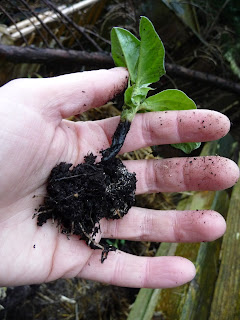All wasn't that bad. Here's what it really looked like:
Don't worry - the shed fully recovered from its little mishap!
I was relieved when my husband and I lifted the shed back up carefully and found that apart from a few (probably) surprised spiders, the shed and all its goods were fine.
So, now to being totally honest and admitting that my two plots look absolutely awful at the moment. I'm not the only one but with two plots (one being 5 pole, the other 10 pole) it's not going to be easy work. Needless to say, the soil was quite easy to dig even after all the rain and I had the whole family chipping in to get it all started. I think this will be an interesting year on my plot, with a lot of developing ideas and new crops.
Even though it wasn't easy, my son enjoyed a bit of digging. In front of him is box hedging that I hope will grow well and create a nice area for herbs and edible flowers.
My daughter getting stuck in with removing last year's sweetcorn plants. She's specifically requested lots more sweetcorn for this year.
Meanwhile, in the polytunnel...
Things have been growing well, despite losing some broad beans earlier to root rot. I now have more broad beans germinating, adding to the season's length. This time I sowed a different variety: Masterpiece green longpod. I have grown these before and they have been reliable in the past so fingers crossed.
Seedlings are popping up all over the place in the polytunnel, which is very pleasing to the eye. Peas and broad beans are growing on, needing repotting if I don't plant them out on the allotment very soon. I could do this but I would need to protect them from frost as they won't be hardy. Frosts can still occur this time of year right up to May. I made the mistake of planting out runner beans in late April last year without protection and lost the lot. What was hard to comprehend was that there wasn't a frost forecast that particular evening, nor did many other allotment holders suffer this bout of cold. Only two plots were affected and with mine losing the runner beans I had no spare plants. I shan't be making that mistake again.
The heated propagators have been switched off as things are warming up naturally now, but I still keep the covers on. These are a selection of tomatoes and aubergines.
Masterpiece green longpod doing its thing.
The Aquadulce broad beans are fast outgrowing their pots. Here you can see the roots poking through the bottom of the pot. If I don't get a plot ready then I will have to repot these to keep them growing on until I have a space prepared for them on the allotment.
So here's a list of what I'm doing now to prepare for the growing year:
- Prepping the allotment: by digging and adding nutrients to the soil (for me this is using well rotted chicken manure from my own feathered kin at home).
- Switching off heated propagators. Temperatures are rising now and so I will let nature play its part instead as we look ahead to March.
- Potting on seedlings. When these start getting too big for their seed tray cells they need to be moved on.
So, prepare yourself for any mishaps like storm Doris causing some damage, also start looking at what you want to grow that will need to be sown in March. There's lots of different things that can be started off in March so take your time to choose what you would enjoy growing and eating. Finally, be ready for pests. Having spoken to a fellow allotment holder today, he told me that he had some early broad beans which he was hardening off, only to be eaten by a grey squirrel one afternoon. It's a constant battle but I enjoy it!
Keep gardening!
































